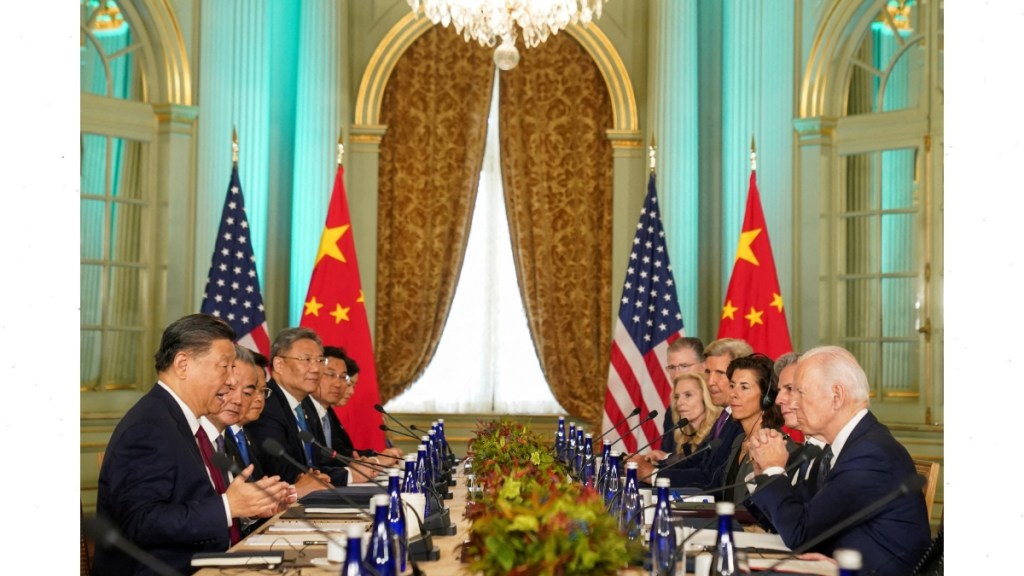By Prof (Dr) Nishakant Ojha
Relations between the United States and China are nearing a dangerous precipice, with growing concerns about the potential for conflict—whether economic or military—between the two superpowers. While neither nation desires war, the tension between them is escalating, driven by a range of factors, including mutual provocations, political pressures, and geopolitical manoeuvring. Geopolitically it is feared that these dynamics could lead to an inevitable clash, with potentially disastrous consequences for both countries and the global order, similar to the aftermath of Russia’s invasion of Ukraine but on a much larger scale.
The key issue lies in the fact that both countries are treading dangerously close to each other’s “red lines.” These boundaries, if crossed, could push them into an irreversible conflict. The use of brinkmanship—where each side pushes the other to the edge without intending to cross the line—is intensifying the risk of such an outcome. While both nations are currently engaging in tactical talks to avoid outright war, such as addressing Taiwan President Tsai’s visit to the US, there is a growing belief that the trajectory toward conflict is becoming unavoidable due to the political climate in both nations and broader global considerations.
In the US, internal political dynamics play a significant role. President Joe Biden’s administration faces a fragmented political landscape, with many hawkish voices pushing for a tougher stance on China. This became evident during high-profile incidents such as Nancy Pelosi’s visit to Taiwan and the balloon surveillance incident, where Biden’s ability to control the situation was limited. As the US approaches the 2024 election cycle, anti-China sentiment will likely escalate. Political pressure from both parties, and particularly from Republican congressional hawks, is expected to lead to more aggressive rhetoric and actions against China, heightening the risk of crossing red lines.
Several key issues pose the greatest danger of tipping the relationship over the edge. Chief among them is Taiwan. A well-known red line for China is any move by the US or Taiwan to support Taiwanese independence. Such a move, Beijing has made clear, would be seen as an act of war. With the US increasingly signalling support for Taiwan’s defence, including potential arms sales, the likelihood of crossing this red line grows. Other areas of tension include China’s military actions around Taiwan, its growing ties with Russia, and US sanctions on Chinese access to critical technologies like semiconductors. These actions have already led China to consider retaliatory economic measures, such as potential sanctions on American companies like Micron Technology, which could have devastating consequences for global trade.
The growing competition over control of essential technologies and minerals is further exacerbating tensions. Both countries are moving to secure critical supply chains, leading to a trend of “onshoring” and “friendshoring” that is reshaping alliances and global economic ties. This shift is already affecting relationships with other key nations, such as South Korea and Saudi Arabia, as countries are forced to choose sides in this escalating rivalry.
Beyond these immediate concerns, there are numerous other points of contention, from cybersecurity to business protocols, all of which are likely to intensify in the coming months. If these issues lead to a breakdown in US-China trade, the economic impact could be devastating, mirroring the collapse of economic relations between the West and Russia but on a far larger scale. Such a breakdown could severely disrupt global supply chains and trade, with long-term damage to both economies and the world at large.
As the possibility of conflict looms larger, there is increasing focus on what form such a war might take and how it could be contained. Discussions around potential economic sanctions or military confrontations suggest a desire to limit the scope of any conflict, perhaps by agreeing on what items might be exempt from sanctions or limiting the use of nuclear and cyber weapons. However, history has shown that conflicts at this stage often have terrible economic consequences and carry a high risk of escalation into full-scale war.
While many policymakers on both sides are deeply concerned about the potential for war and are working to avoid it, the danger remains real. China, in particular, appears to be adopting a more restrained approach, wary of being baited into a conflict it wants to avoid. However, there is a real risk that continued provocations from the US, driven by political pressures, could lead to a tit-for-tat escalation that neither side can control.
In nutshell we can see that the US and China, two global giants, now find themselves engaged in a dangerous game of brinkmanship—each pushing the other closer to the edge of a cliff that, if crossed, could pull much of the world into a devastating conflict. One more significant concern in China is the rise of populism, where people are increasingly adopting strong, adversarial opinions, while the government seeks to maintain uniformity in thought. Despite unified leadership, there is considerable internal conflict among different factions and citizens on various issues.
The author is a renowned expert in Counter-Terrorism and Counter-Insurgency in the Middle East and West Asia, with specialized knowledge in National Security as a foreign affairs specialist.
Disclaimer: Views expressed are personal and do not reflect the official position or policy of FinancialExpress.com Reproducing this content without permission is prohibited.
